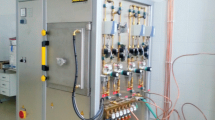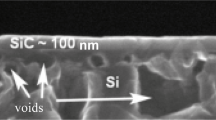Abstract
A new method of solid-state epitaxy of silicon carbide (SiC) on silicon (Si) is proposed theoretically and realized experimentally. Films of various polytypes of SiC on Si(111) grow through a chemical reaction (at T = 1100–1400°C) between single-crystal silicon and gaseous carbon oxide CO (at p = 10–300 Pa). Some silicon atoms transform into gaseous silicon oxide SiO and escape from the system, which brings about the formation of vacancies and pores in the silicon near the interface between the silicon and the silicon carbide. These pores provide significant relaxation of the elastic stresses caused by the lattice misfit between Si and SiC. X-ray diffraction, electron diffraction, and electron microscopy studies and luminescence analysis showed that the silicon carbide layers are epitaxial, homogeneous over the thickness, and can contain various polytypes and a mixture of them, depending on the growth conditions. The typical pore size is 1 to 5 μm at film thicknesses of ∼20 to 100 nm. Thermodynamic nucleation theory is generalized to the case where a chemical reaction occurs. Kinetic and thermodynamic theories of this growth mechanism are constructed, and the time dependences of the number of new-phase nuclei, the concentrations of chemical components, and the film thickness are calculated. A model is proposed for relaxation of elastic stresses in a film favored by vacancies and pores in the substrate.
Similar content being viewed by others
References
Silicon Carbide: A Review of Fundamental Questions and Application to Current Device Technology, Ed. by W. J. Choyke, H. M. Matsunami, and G. Pensl (Akademie, Berlin, 1998), Vols. I, II.
A. Fissel, Phys. Rep. 379, 149 (2003).
S. Nishino, J. A. Powell, and H. A. Will, Appl. Phys. Lett. 42, 460 (1983).
C. Ricciardi, E. Aimo Boot, F. Gioegis, P. Mandracci, U. Meotto, and G. Barucco, Appl. Surf. Sci. 238, 331 (2004).
Y. Abe, J. Komiyama, S. Suzuki, and H. Nakanishi, J. Cryst. Growth 283, 41 (2005).
J. Tolle, R. Roucka, P. A. Crozier, A. V. G. Chizmeshya, I. S. T. Tsong, and J. Kouvetakis, Appl. Phys. Lett. 81, 2181 (2002).
N. S. Savkina, V. V. Ratnikov, A. Yu. Rogachev, V. B. Shuman, A. S. Tregubova, and A. A. Volkova, Fiz. Tekh. Poluprovodn. (St. Petersburg) 36(7), 812 (2002) [Semiconductors 36 (7), 758 (2002)].
A. R. Bushroa, C. Jacob, H. Saijo, and S. Nishino, J. Cryst. Growth 271, 200 (2004).
S. A. Kukushkin, A. V. Osipov, and N. A. Feoktistov, RF Patent Appl. No. 2 008 102 398 (January 22, 2008).
C. J. Mogab and H. J. Leamy, J. Appl. Phys. 45, 1075 (1974).
G. Dufour, F. Rouchet, F. C. Stedile, Ch. Poncey, M. de Crescenzi, R. Gunnella, and M. Froment, Phys. Rev. B: Condens. Matter 56, 4266 (1997).
V. Palermo, A. Parisini, and D. Jones, Surf. Sci. 600, 1140 (2006).
M. Di Ventra and S. T. Pantelides, Phys. Rev. Lett. 83, 1628 (1999).
S. Wang, M. Di Ventra, S. G. Kim, and S. T. Pantelides, Phys. Rev. Lett. 86, 5946 (2001).
Thermodynamical Properties of Individual Substances, Ed. by V. P. Glushko (Nauka, Moscow, 1979), Vols. 1, 2.
P. Patzner, A. V. Osipov, and P. Hess, Appl. Phys. A: Mater. Sci. Process. 85, 145 (2006).
L. D. Landau and E. M. Lifshitz, Course of Theoretical Physics, Vol. 5: Statistical Physics (Nauka, Moscow, 1976; Butterworth-Heinemann, Oxford, 1984).
T. de Donder and P. van Rysselberghe, Thermodynamic Theory of Affinity: A Book of Principles (Oxford University Press, Oxford, 1936; Metallurgiya, Moscow, 1984).
I. Prigogine and R. Defay, Chemical Thermodynamics (Longman, London, 1954; Nauka, Novosibirsk, 1966).
S. A. Kukushkin and A. V. Osipov, Usp. Fiz. Nauk 168(10), 1083 (1998) [Phys.-Usp. 41 (10), 983 (1998)].
S. A. Kukushkin, Usp. Mekh. 2(2), 21 (2003).
S. A. Kukushkin, J. Appl. Phys. 98, 033 503 (2005).
L. A. Zhukova and M. A. Gurevich, Electron Diffraction Analysis of Surface Layers and Films of Semiconductors (Metallurgiya, Moscow, 1971) [in Russian].
Author information
Authors and Affiliations
Corresponding author
Additional information
Original Russian Text © S.A. Kukushkin, A.V. Osipov, 2008, published in Fizika Tverdogo Tela, 2008, Vol. 50, No. 7, pp. 1188–1195.
Rights and permissions
About this article
Cite this article
Kukushkin, S.A., Osipov, A.V. New method for growing silicon carbide on silicon by solid-phase epitaxy: Model and experiment. Phys. Solid State 50, 1238–1245 (2008). https://doi.org/10.1134/S1063783408070081
Received:
Published:
Issue Date:
DOI: https://doi.org/10.1134/S1063783408070081




